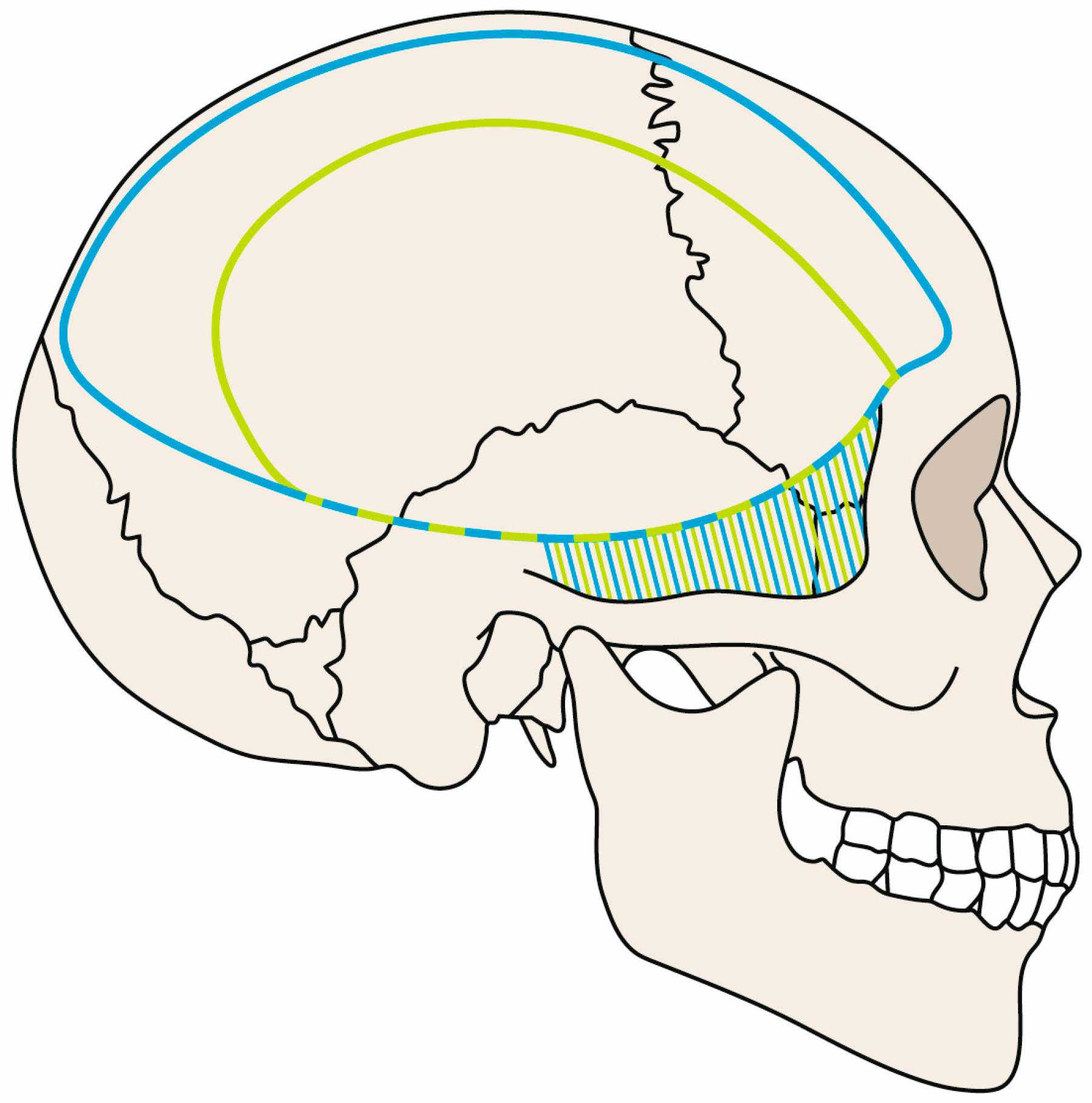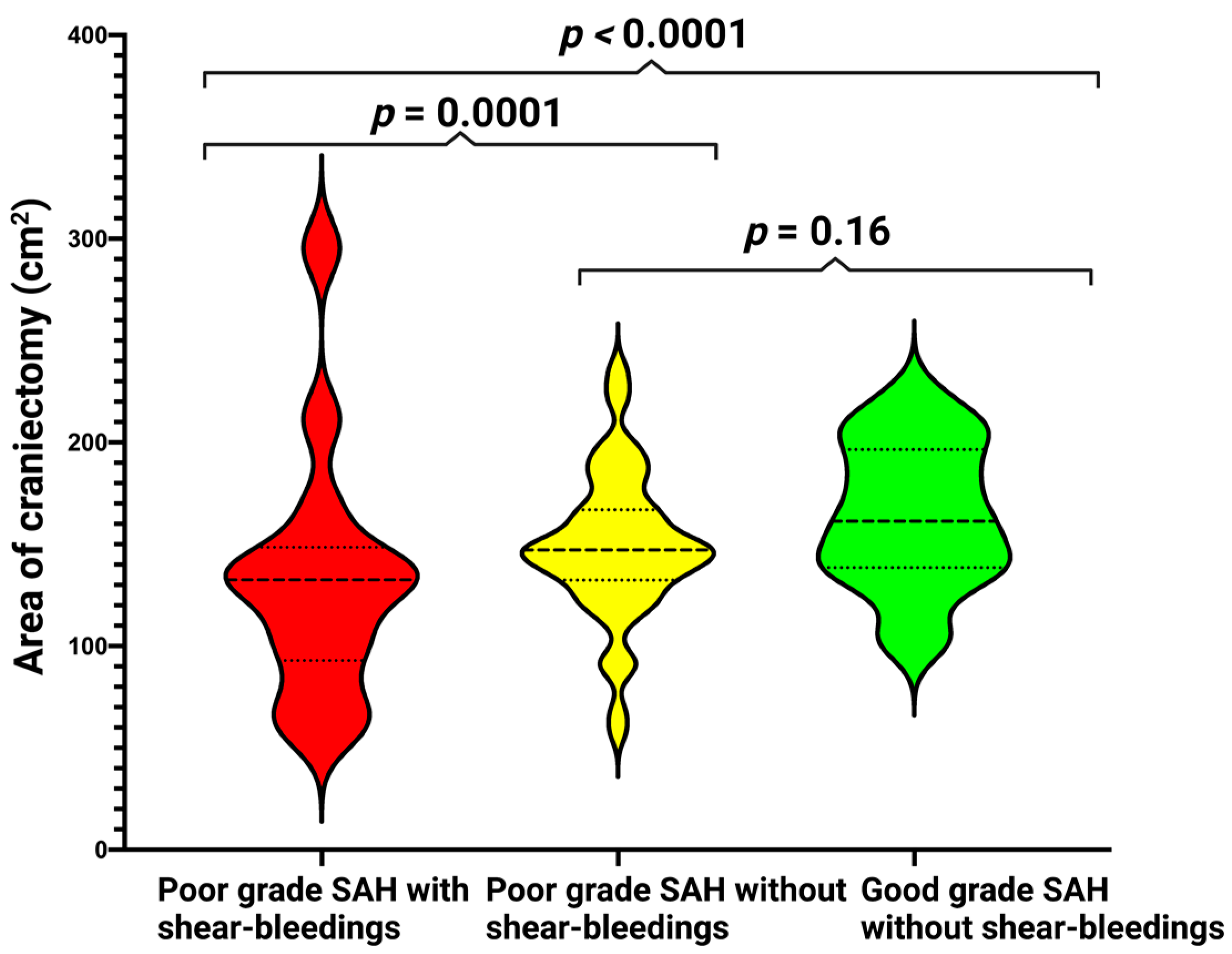Size of Craniectomy Predicts Approach-Related Shear Bleeding in Poor-Grade Subarachnoid Hemorrhage
Abstract
1. Introduction
2. Materials and Methods
3. Results
4. Discussion
5. Conclusions
Author Contributions
Funding
Institutional Review Board Statement
Informed Consent Statement
Data Availability Statement
Conflicts of Interest
References
- Güresir, E.; Schuss, P.; Vatter, H.; Raabe, A.; Seifert, V.; Beck, J. Decompressive craniectomy in subarachnoid hemorrhage. Neurosurg. Focus 2009, 26, E4. [Google Scholar] [CrossRef] [PubMed]
- Jabbarli, R.; Darkwah Oppong, M.; Roelz, R.; Pierscianek, D.; Shah, M.; Dammann, P.; Scheiwe, C.; Kaier, K.; Wrede, K.H.; Beck, J.; et al. The PRESSURE score to predict decompressive craniectomy after aneurysmal subarachnoid hemorrhage. Brain Commun. 2020, 2, fcaa134. [Google Scholar] [CrossRef] [PubMed]
- Smith, E.R.; Carter, B.S.; Ogilvy, C.S. Proposed use of prophylactic decompressive craniectomy in poor-grade aneurysmal subarachnoid hemorrhage patients presenting with associated large sylvian hematomas. Neurosurgery 2002, 51, 117–124. [Google Scholar] [CrossRef] [PubMed]
- Otani, N.; Takaso, Y.; Masaoka, H.; Hayakawa, T.; Yoshino, Y.; Yatsushige, H.; Miyawaki, H.; Sumioshi, K.; Chikashi, A.; Takeuchi, S.; et al. Surgical outcome following decompressive craniectomy for poor-grade aneurysmal subarachnoid hemorrhage in patients with associated massive intracerebral or sylvian hematomas. Cerebrovasc. Dis. 2008, 26, 612–617. [Google Scholar] [CrossRef] [PubMed]
- Buschmann, U.; Yonekawa, Y.; Fortunati, M.; Cesnulis, E.; Keller, E. Decompressive hemicraniectomy in patients with subarachnoid hemorrhage and intractable intracranial hypertension. Acta Neurochir. 2007, 149, 59–65. [Google Scholar] [CrossRef]
- Güresir, E.; Lampmann, T.; Brandecker, S.; Czabanka, M.; Fimmers, R.; Gempt, J.; Haas, P.; Haj, A.; Jabbarli, R.; Kalasauskas, D.; et al. PrImary decompressive Craniectomy in AneurySmal Subarachnoid hemOrrhage (PICASSO) trial: Study protocol for a randomized controlled trial. Trials 2022, 23, 1027. [Google Scholar] [CrossRef]
- Holsgrove, D.T.; Kitchen, W.J.; Dulhanty, L.; Holland, J.P.; Patel, H.C. Intracranial hypertension in subarachnoid hamorrhage: Outcome after decompressive craniectomy. Acta Neurochir. Suppl. 2014, 119, 53–55. [Google Scholar]
- Schirmer, C.M.; Hoit, D.A.; Malek, A.M. Decompressive hemicraniectomy for the treatment of intractable intracranial hypertension after aneurysmal subarachnoid hemorrhage. Stroke 2007, 38, 987–992. [Google Scholar] [CrossRef]
- Vychopen, M.; Schneider, M.; Borger, V.; Schuss, P.; Behning, C.; Vatter, H.; Güresir, E. Complete Hemispheric exposure vs. Superior sagittal sinus sparing craniectomy: Incidence of shear-bleeding and shunt-dependency. Eur. J. Trauma Emerg. Surg. 2022, 48, 2449–2457. [Google Scholar] [CrossRef]
- Tanrikulu, L.; Oez-Tanrikulu, A.; Weiss, C.; Scholz, T.; Schiefer, J.; Clusmann, H.; Schubert, G.A. The bigger, the better? About the size of decompressive hemicraniectomies. Clin. Neurol. Neurosurg. 2015, 135, 15–21. [Google Scholar] [CrossRef]
- Hawryluk, G.W.J.; Rubiano, A.M.; Totten, A.M.; O’Reilly, C.; Ullman, J.S.; Bratton, S.L.; Chesnut, R.; Harris, O.A.; Kissoon, N.; Shutter, L.; et al. Guidelines for the Management of Severe Traumatic Brain Injury: 2020 update of the decompressive craniectomy recommendations. Neurosurgery 2020, 87, 427–434. [Google Scholar] [CrossRef]
- Mussack, T.; Wiedemann, E.; Hummel, T.; Biberthaler, P.; Kanz, K.G.; Mutschler, W. Die sekundäre Dekompressionstrepanation bei zunehmendem posttraumatischem Hirnödem nach primärer Entlastungskraniotomie [Secondary decompression trepanation in progressive post-traumatic brain edema after primary decompressive craniotomy]. Unfallchirurg 2003, 106, 815–825. [Google Scholar] [CrossRef] [PubMed]
- Quig, N.; Shastri, D.; Zeitouni, D.; Yap, E.; Sasaki-Adams, D. Bilateral Decompressive Hemicraniectomy for Diffuse Cerebral Edema and Medically Refractory Elevated Intracranial Pressure in Aneurysmal Subarachnoid Hemorrhage: A Case Series. Cureus 2021, 13, e18057. [Google Scholar] [CrossRef] [PubMed]
- Sedney, C.L.; Julien, T.; Manon, J.; Wilson, A. The effect of craniectomy size on mortality, outcome and complications after decompressive craniectomy at a rural trauma center. J. Neurosci. Rural Pract. 2014, 5, 212–217. [Google Scholar] [CrossRef]
- Neugebauer, H.; Fiss, I.; Pinczolits, A.; Hecht, N.; Witsch, J.; Dengler, N.F.; Vajkoczy, P.; Jüttler, E.; Woitzik, J. Large Size Hemicraniectomy Reduces Early Herniation in Malignant Middle Cerebral Artery Infarction. Cerebrovasc. Dis. 2016, 41, 283–290. [Google Scholar] [CrossRef] [PubMed]
- Jiang, J.Y.; Xu, W.; Li, W.P.; Xu, W.H.; Zhang, J.; Bao, Y.H.; Ying, Y.H.; Luo, Q.Z. Efficacy of standard trauma craniectomy for refractory intracranial hypertension with severe traumatic brain injury; a multicenter, prospective, randomized controlled study. J. Neurotrauma 2005, 22, 623–628. [Google Scholar] [CrossRef]
- Jabbarli, R.; He, S.Q.; Darkwah Oppong, M.; Herten, A.; Chihi, M.; Pierscianek, D.; Dannabbm, P.; Sure, U.; Wrede, K.H. Size does matter: The role of decompressive craniectomy extent for outcome after aneurysmal subarachnoid hemorrhage. Eur. J. Neurol. 2021, 28, 2200–2207. [Google Scholar] [CrossRef]
- Yu, H.; Guo, L.; He, J.; Kong, J.; Yang, M. Role of decompressive craniectomy in the management of poor-grade aneurysmal subarachnoid hemorrhage: Short- and long-term outcomes in a matched-pair study. Br. J. Neurosurg. 2021, 35, 785–791. [Google Scholar] [CrossRef]
- Goedemans, T.; Verbaan, D.; Coert, B.A.; Sprengers, M.E.S.; van den Berg, R.; Vandertop, W.P.; van den Munckhof, P. Decompressive craniectomy in aneurysmal subarachnoid haemorrhage for hematoma or oedema versus secondary infarction. Br. J. Neurosurg. 2018, 32, 149–156. [Google Scholar] [CrossRef]
- D’Ambrosio, A.L.; Sughrue, M.E.; Yorgason, J.G.; Mocco, J.D.; Kreiter, K.T.; Mayer, S.A.; McKhann, G.M., 2nd; Connolly, E.S., Jr. Decompressive hemicraniectomy for poor-grade aneurysmal subarachnoid hemorrhage patients with associated intracerebral hemorrhage: Clinical outcome and quality of life assessment. Neurosurgery 2005, 56, 12–19; discussion 19–20. [Google Scholar] [CrossRef]
- Schur, S.; Martel, P.; Marcoux, J. Optimal Bone Flap Size for Decompressive Craniectomy for Refractory Increased Intracranial Pressure in Traumatic brain Injury: Considering the Patient’s Head Size. World Neurosurg. 2020, 137, e430–e436. [Google Scholar] [CrossRef] [PubMed]
- Neifert, S.N.; Chapman, E.K.; Martini, M.L.; Shuman, W.H.; Schupper, A.J.; Oermann, E.K.; Mocco, J.; Macdonald, R.L. Aneurysmal Subarachnoid Hemorrhage: The Last Decade. Transl. Stroke Res. 2021, 12, 428–446. [Google Scholar] [CrossRef] [PubMed]
- Qiu, W.; Guo, C.; Shen, H.; Chen, K.; Wen, L.; Huang, H.; Ding, M.; Sun, L.; Jiang, Q.; Wang, W. Effects of unilateral decompressive craniectomy on patients with unilateral acute post-traumatic brain swelling after severe traumatic brain injury. Crit. Care 2009, 13, R185. [Google Scholar] [CrossRef] [PubMed]
- Kurland, D.B.; Khaladj-Ghom, A.; Stokum, J.A.; Carusillo, B.; Karimy, J.K.; Gerzanich, V.; Sahuquillo, J.; Simard, J.M. Complications Associated with Decompressive Craniectomy: A Systematic Review. Neurocrit. Care 2015, 23, 292–304. [Google Scholar] [CrossRef]
- Kazumata, K.; Kamiyama, H.; Yokoyama, Y.; Asaoka, K.; Terasaka, S.; Itamoto, K.; Osanai, T. Poor-grade ruptured middle cerebral artery aneurysm with intracerebral hematoma: Bleeding characteristics and management. Neurol. Med. Chir. 2010, 50, 884–892. [Google Scholar] [CrossRef] [PubMed]
- Arikan, F.; Vilalta, J.; Romero, F.J.; Porta, I.; Martínez-Ricarte, F.R.; Sahuquillo, J. Craniectomía descompresiva primaria en la hemorragia subaracnoidea aneurismática. Resultados deun estudio piloto en 11 casos [Primary decompressive craniectomy in patients with aneurysmatic subarachnoid hemorrhage. Results of a pilot study in 11 cases]. Neurocirugia 2010, 21, 452–460. [Google Scholar] [CrossRef] [PubMed]
- Wang, Q.P.; Ma, J.P.; Zhou, Z.M.; You, C. Impact of operation details on hydrocephalus after decompressive craniectomy. Neurosciences 2016, 21, 10–16. [Google Scholar] [CrossRef]



| Patient Characteristic | n |
|---|---|
| Male | 28 |
| Female | 60 |
| WFNS 2 | 10 |
| WFNS 3 | 11 |
| WFNS 4 | 16 |
| WFNS 5 | 51 |
| Fisher-grade 2 | 2 |
| Fisher-grade 3 | 82 |
| Fisher-grade 4 | 4 |
| Mean age (±MD) in years | 55.04 ± 13.53 |
| Shear bleeding complications | 14 |
| Good-Grade SAH (n = 21) | Poor-Grade SAH (n = 67) | p Values | |
|---|---|---|---|
| Sex (Male:Female) | 10:11 | 18:49 | 0.1 |
| Arterial hypertension | 9 | 24 | 0.6 |
| Smoking | 9 | 26 | 0.8 |
| Preoperative blood thinners | 3 | 16 | 0.5 |
| PRESSURE score (IQR) | 6 (4.5–7) | 6 (5–7) | |
| Aneurysm localization: | |||
| Anterior cerebral artery (A1 segment) | 1 | 2 | |
| Anterior cerebral artery (A2 segment) | 0 | 1 | |
| Anterior cerebral artery (A3–A4 segment) | 0 | 2 | |
| Anterior communicating artery | 5 | 13 | |
| Internal carotid artery—ophthalmic segment | 0 | 5 | |
| Internal carotid artery—terminal segment | 2 | 12 | |
| Medial cerebral artery—bifurcation | 9 | 33 | |
| Basilar artery—terminal segment | 0 | 1 | |
| Posterior cerebellar artery | 1 | 1 | |
| Aneurysm size (mm) | 11 ± 7.3 | 11 ± 7.7 |
| Poor-Grade SAH with Shear Bleedings (n = 14) | Poor-Grade SAH without Shear Bleedings (n = 53) | p Value | |
|---|---|---|---|
| mRS < 4 in 6 months | 12 | 8 | 0.99 |
| 1-year mortality | 10 | 23 | 0.07 |
| VP shunt implantations | 2 | 18 | 0.2 |
Disclaimer/Publisher’s Note: The statements, opinions and data contained in all publications are solely those of the individual author(s) and contributor(s) and not of MDPI and/or the editor(s). MDPI and/or the editor(s) disclaim responsibility for any injury to people or property resulting from any ideas, methods, instructions or products referred to in the content. |
© 2023 by the authors. Licensee MDPI, Basel, Switzerland. This article is an open access article distributed under the terms and conditions of the Creative Commons Attribution (CC BY) license (https://creativecommons.org/licenses/by/4.0/).
Share and Cite
Vychopen, M.; Wach, J.; Lampmann, T.; Asoglu, H.; Vatter, H.; Güresir, E. Size of Craniectomy Predicts Approach-Related Shear Bleeding in Poor-Grade Subarachnoid Hemorrhage. Brain Sci. 2023, 13, 371. https://doi.org/10.3390/brainsci13030371
Vychopen M, Wach J, Lampmann T, Asoglu H, Vatter H, Güresir E. Size of Craniectomy Predicts Approach-Related Shear Bleeding in Poor-Grade Subarachnoid Hemorrhage. Brain Sciences. 2023; 13(3):371. https://doi.org/10.3390/brainsci13030371
Chicago/Turabian StyleVychopen, Martin, Johannes Wach, Tim Lampmann, Harun Asoglu, Hartmut Vatter, and Erdem Güresir. 2023. "Size of Craniectomy Predicts Approach-Related Shear Bleeding in Poor-Grade Subarachnoid Hemorrhage" Brain Sciences 13, no. 3: 371. https://doi.org/10.3390/brainsci13030371
APA StyleVychopen, M., Wach, J., Lampmann, T., Asoglu, H., Vatter, H., & Güresir, E. (2023). Size of Craniectomy Predicts Approach-Related Shear Bleeding in Poor-Grade Subarachnoid Hemorrhage. Brain Sciences, 13(3), 371. https://doi.org/10.3390/brainsci13030371







